How to Freeze Corn/ On or off the Cob
This page may contain affiliate links. More Information.
Learn how to freeze corn, either on the cob or off the cob, as sweet kernels. Some folks turn their nose up at canned corn. I like it, but I have to admit that freezing corn results in a fresher dish on your table.
Of course, nothing beats corn on the cob picked fresh from the garden, with butter and salt dripping down your chin! But the season for fresh only lasts so long, canning and freezing keep that summer taste all year.

- What About Freezing Corn with the Husks On?
- Cream-Style Corn Recipe After You Have Preserved It
- How Do You Use Home Frozen Corn?
- Can You Freeze Corn on the Cob Without Blanching?
- How Long Does Frozen Corn Keep in the Freezer?
Freezing Corn/ Step by step
Here’s how to freeze corn.
- First, you’ll need to husk corn and remove silk.
- Then blanch the ears of corn.
- Finally decide how you want to package it. (on the cob, off the cob, freezer bags, storage containers… etc.
Read on for details on all the options and my favorite.
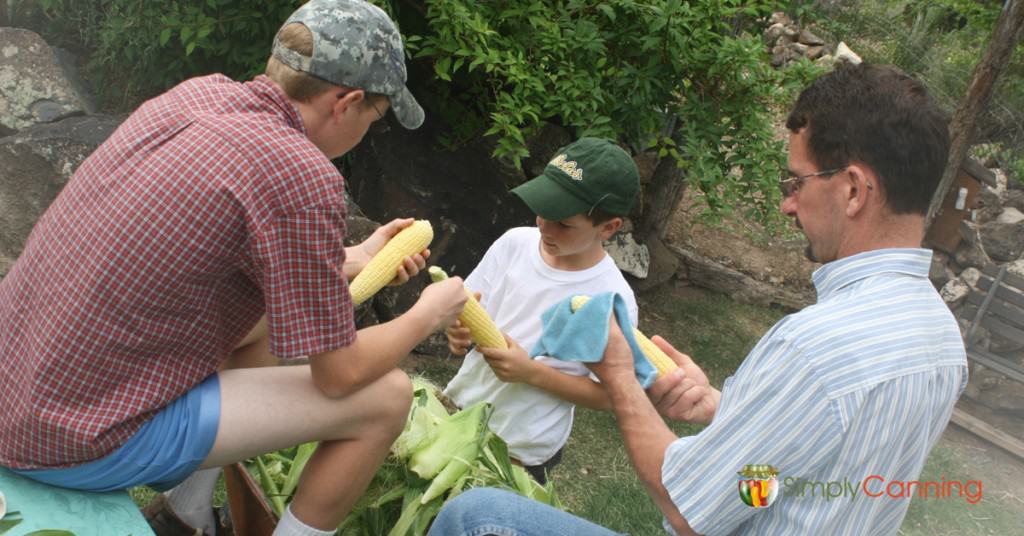
Get your corn huskers (shuckers or whatever you call it) to work! Make sure they (or you) do their best to get all the hair (silk) off.
How to Blanch Corn on the Cob
While the corn is being husked, start boiling water, either in a large stockpot or your blancher. I find a large stockpot works well for me. Blanch your corn 3-5 cobs at a time, depending on the size of the corn and the size of your pot.
Plunge the cobs in boiling water for 5-6 minutes, depending on the size of the cob. Larger cobs will be blanched for a longer time.
Start counting your time as soon as the cobs enter the water. Do not wait for the water to come to a boil again. Remove cobs with tongs. Place immediately into a sink or pot of ice water to cool and stop the cooking process.
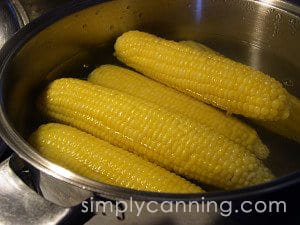
Allow the corn to sit in the water for at least 2 minutes. Keep this water cold, adding ice if necessary. Remove the cobs from the cold water and allow to drain.
How are you going to package your corn
If you are freezing corn off the cob…cut the kernels from the cob. This is my preferred method so I list it first. But freezing on the cob is possible as well. If you want to freeze corn on the cob, skip down lower on the page.
How to Freeze Corn Off the Cob
How to Slice the Kernels from the Cob
Set the cob on end and run your knife down the sides, cutting off the kernels. Or use this handy tool to slice the whole cob at once. (Try not to cut into the cob. I aim for getting off about 3/4 of the kernel.)
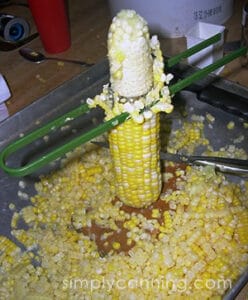
I use a large cookie sheet to catch the kernels; a large, flat dish like a cake pan would also work.
Be warned…it is messy. The kernels will spit juicy goodness all over. I have a large kitchen counter that works well because it is easy clean up. You might even want to do this outside on a tabletop or somewhere you can clean up easily.
Watch my short video just below to see the easiest method we have found. When you have a few cobs to do, the above method works fine. But if you have a lot of corn to process, try this bucket method my husband came up with.
The tool you see him using in the video is the same tool you see in the image above. I believe it is called a corn stripper. They are sold at Amazon and many farm supply stores. The one we have is many, many years old. It is not marked with a name brand of any sort, so I’m not sure what exactly it is. 🙂
Place the corn into freezer containers. (I prefer freezer bags.) Remove as much air as possible, seal, label, and freeze.
Place bags in the freezer in single layers. This allows the corn to freeze quickly. When the corn is completely frozen, you may stack the bags for convenience.
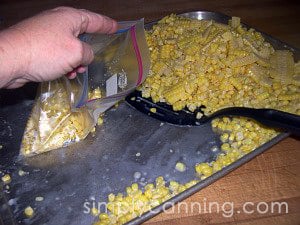
If you want cream-style corn, simply scrape the corn cobs with the edge of your knife after you cut the kernels off. This will remove any juice and pulp left on the cob. Stir this into the corn kernels in a large pot. Package just the same as above.
How to Freeze Corn On the Cob
Personally, I’ve only done this once or twice. I just don’t care for frozen corn on the cob, as I find the taste is not as good…and it takes up way too much freezer space to freeze the whole cob. I’d much rather freeze the kernels only.
But if you want to, learning how to freeze corn on the cob is super easy too.
Husk and blanch corn cobs using the same blanching methods as described above.
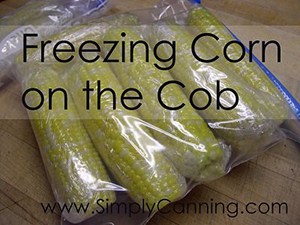
Cool and drain cobs. Wrap ears individually with plastic wrap. Then place the cobs in gallon freezer bags or wrap in freezer paper.
Seal, label, and freeze. Place cobs in freezer in a single layer. Allow to freeze completely, then stack for convenience.
Recipe Card
How to Freeze Corn Tips & FAQs
Yes you can freeze in mason jars. I generally don’t like to. I worry about glass breakage, they take up more room in my freezer, and you can’t get as much air out of the jar as you could a plastic bag.
If you want to though it is fine. You’ll want to use a wide mouth jar and fill it just up to the shoulder. This allows for expansion. If you fill it too much the jar may break as the food freezes and expands.
You want your food to freeze as quickly as possible. If you’ve got a whole stack of freezer bags the food towards the center of the pile will take longer to freeze. a single layer will freeze much quicker then you can stack your already frozen bags to save space.
If you need to you could go ahead and stack 2 or possibly 3 together. But a single layer is better.
I have never done this myself. However, I’m going to put this right here as I’ve read many many comments from people who simply put the cob, husks and all, in the freezer.
I’ve read rave results from this method. I admit, it is tempting. But I generally like to blanch first and with the husk on method that would not work.
You might want to give it a try.
Just like regular, store-bought frozen corn! 🙂 Heat it up and eat it. You can simmer it, bake it, put it in the microwave.
You CAN freeze corn on the cob without blanching, but I don’t recommend it. Blanching helps preserve the taste and texture of vegetables during freezing, including corn on the cob. Not to mention if you’re cutting it off the cob, blanching helps make it a little easier to cut off of the cob.
According to the National Center for Home Food Preservation, frozen vegetables generally keep in the freezer for 8-12 months. No longer than a year is ideal. If it has been a year, just make a plan to use it up. I’ve kept mine in the freezer for longer. Just watch for signs of freezer burn.
Some other ways to preserve corn.
Corn relish recipes are simple and straightforward, which is one of the reasons it is so good! Learn how to make and preserve your own pickled corn with SimplyCanning.com
Corn cob jelly isn’t often heard of and can get various reactions. Until you try it, you don’t know what you’re missing! SimplyCanning.com takes you through the process in this easy-to-follow guide.
Canning corn at home is a good alternative to freezing it all. Save some freezer space and create convenience for easy meals and side dishes. All you need to know!
Pin This to Find Later!
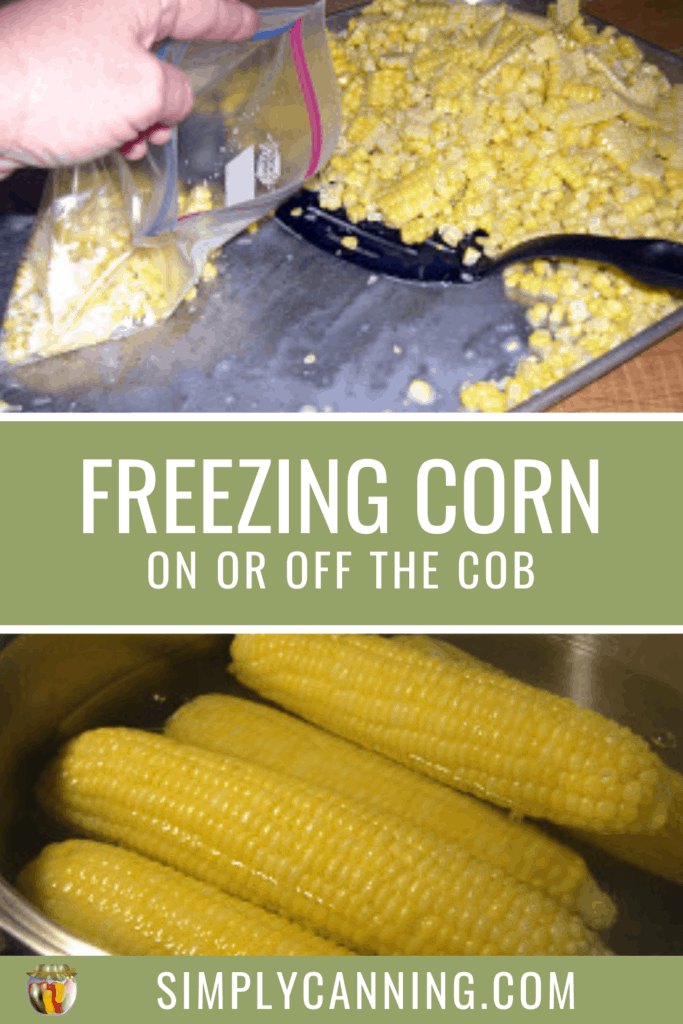


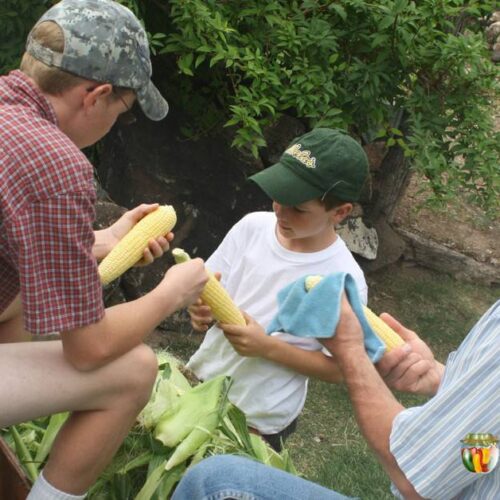
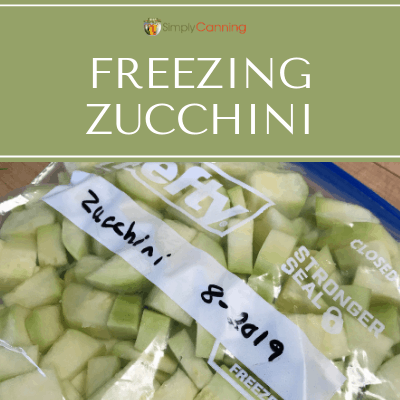
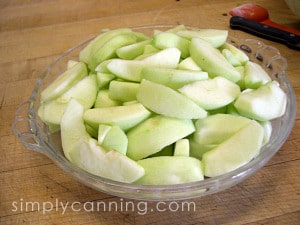
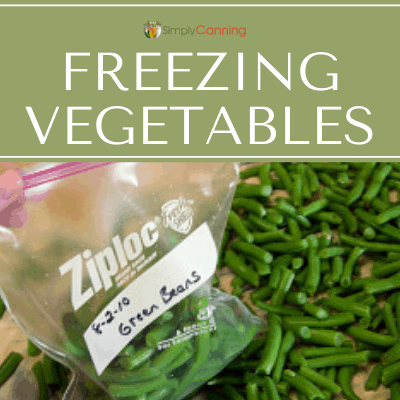
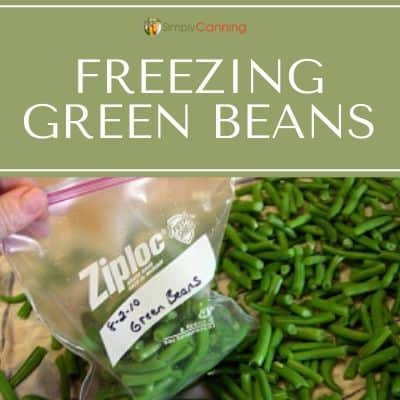
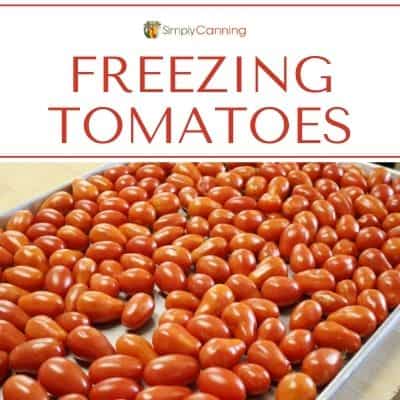
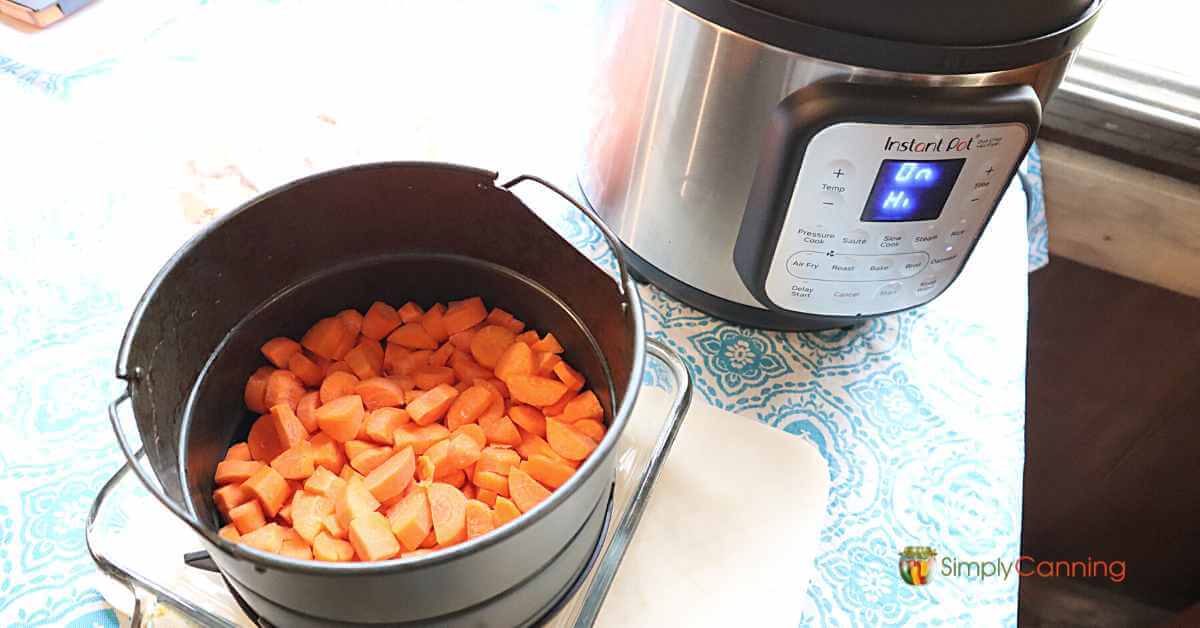
Can you advise if & how to revive my frozen corn on the cob; I took off most of the husk & vacuum sealed the cobs & now when I unfreeze them they are all rubbery & watery. I am so frustrated & sad that I didn’t blanch them first: help please!
Thanks!
Unfortunately no, I’m not sure how to make them better. Maybe someone else will see this and have some suggestions. You might try cutting them off the cobs, and simmering with a little extra butter and salt. Maybe getting them off the cob will help with the texture issues a bit?
Hi, I just saw your verse from Thessalonians. I think more people could benefit from that text.
We tried freezing corn on the cob with the silk and husk. We left it in the freezer a couple of weeks and then cooked it. The texture was wonderful BUT there was no flavour to it at all. Sadly, I personally don’t think this is a good option because of the lack of flavour. I have also tried freezer string beans without blanching and the texture was mushy. I’m not going to go to that work and expense to have tasteless, mushy vegetables. I will blanch my all my veggies going forward.
I’m looking at freezing some corn after blanching it but my question is can I still use the cob to make a corn stock after blanching to get the corn off?
I suppose you could. What do you use the corn stock for? Are you trying to make jelly?
-Rachel (Sharon’s assistant)
I use corn stock to make corn soup, summer vegetable soup and even as the liquid in muffin and quick bread recipes. Waste not, want not, and it adds flavour and nutrients instead of using water.
Can you freeze corn on the cob, then unfreeze it and cut it off the cob to freeze
You could, I suppose, but I’d think it might be more difficult to cut off the cob after it’s been frozen.
-Rachel (Sharon’s assistant)
Frozen on the cob tastes much fresher – and much easier to accomplish – than blanched and frozen if it is simply husked, cleaned, and vacuum sealed. You’ll need to trim the ends a bit, maybe, to make them a uniform size for the bag. We do 4 or 5 cobs across in the 11-12″ wide. The still texture gets a little soft, but the taste stays much truer.
What if you cut the corn off the cob before you blanch
You could do that too. I find it easier to strip the corn off if it is blanched first. But either way works.
First I want to thank you for a very informative recipe on corn. I would like to add a few tips if I may. However, I want to bring clarity to a comment you made “gather your huskers.” The correct term is Shuckers because huskers only implies removing the husk and not the silk. The process of removing both is called shucking… 😊 I use a small wooden handle pot / pan brush in running water to remove silk and husk still stuck between rows of kernals. Now if I am going to freeze my cut corn I do not… Read more »
I think it might be a case of different areas using different terms. haha, we have always called it husking the corn. But I’ll probably remember your comment next time I’m working at getting all the silk off! 🙂 I met someone once who called breaking beans up… “snitting”. I’d never heard that before. We always snap the beans.
I froze corn on the cob as directed. Came out great!! Will let you know when I defrost and eat them.